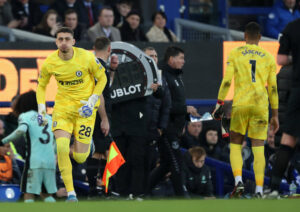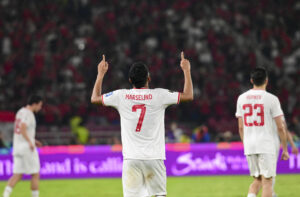When the top of the table in the English Premier League is concerned, there has always been talk of big games and the so-called “lesser“ games. Derbies, top-of-the-table clashes, and those must-win games against lower opposition.
Liverpool vs. Burnley: Match Analysis
Unlike Germany or Spain, where Bayern Munich, Real Madrid or Barcelona play such opponents and most people wonder if it’s going to end 5-0, 6-0, or perhaps 6-1, in England the lower-placed teams can actually bite back.
Burnley tactics
Under manager Sean Dyche, Burnley have become very organised defensively, keeping their 4-4-2 flat shape tight in front of their area, the two lines of four close to one another and not allowing any space for ball-playing teams to wriggle through.

The Clarets tend to make their opponents go wide and put the ball into the box, and then they have them where they want them, with the likes of Ben Mee and Michael Keane completely in command of their own penalty area.
When they win the ball and the time comes to go forward, they are very direct, and will often send a long-ball towards Ashley Barnes, who is the striker charged with winning headers up front. For that he usually needs to drop just a tad deeper, prompting the centre-back marking him to move a few steps forward to challenge.
Once he gets to that ball in the air, he will simply flick it on in behind where Andre Gray will make his run. Gray has pace, strength and decent finishing ability, and such situations are perfect for him.
The win over Liverpool that they achieved this past August was the perfect example of a viable system taking shape for the season. A game where they completely disrupted Liverpool’s attack, forced them wide, pressuring them into mistakes and wrong decisions.
And the game-plan that brought them success on that day was again at work recently at Anfield.
Burnley line-up
There is no doubt that Dyche has put together a formidable and physical side that can cause problems for England’s heavyweights, let alone others. They need just one more win to make the current Premier League campaign the most successful in the club’s history regarding the number of points gathered.
That fact puts things into perspective as far as the progress of Burnley under Sean Dyche is concerned, though they have yet to win a game away from home this season.
Liverpool line-up
As it turned out, Jurgen Klopp and his men were a bit more prepared this time around, or perhaps it would be more accurate to say that from the mileage and experience their team as a unit has gathered since that woeful August game they were more capable of responding on time and in the right fashion.
With Roberto Firmino and Daniel Sturridge missing out through injury, and former Burnley striker Danny Ings suffering another season-ending setback, Klopp had no other option for this game than to play Divock Origi up front. At the other end, Ragnar Klavan kept his place in a 4-3-3 formation due to Dejan Lovren also missing through injury.

But, there were periods when their formation seemed to have shifted, by chance or design, into a 4-2-3-1, with Lallana moving further forward into the number ten role and Wijnaldum slotting deeper beside Emre Can.

The first 30 minutes
For a team like Burnley, physicality is an extremely important aspect of the game. They need to play on the edge of foul, fighting like bulls for every ball in any part of the pitch, and that’s exactly what they did from the start. Liverpool have been doing extremely well against top opposition since Klopp took over the reins, and against a team that likes having the ball, their method of pressing and counter-pressing makes perfect sense.
Clubs like Arsenal or Manchester City often have trouble against such relentless pressing far up the pitch, but against a deep-sitting Burnley side, it doesn’t make much sense, as they will let you have the ball, and then they will press you, get into tackles and duels – basically do anything they can to get the ball and move it forward as quickly as possible, potentially catching you by surprise and making you pay.
And Liverpool paid only seven minutes in. One thing you cannot allow a team that plays direct football (or any team for that matter) is space.
A perfectly measured and directed pass came into the box. Milner hesitates, and tries not to leave the channel between himself and Klavan too open, and yet he has to make sure he doesn’t leave too much space for George Boyd lurking on the flank.
Emre Can, as the midfielder with the most defensive responsibility, is supposed to close down the gap, but he’s not quick enough and Lowton picks his pass. On the other hand, both Barnes and Gray have shifted slightly to the left side of their attack, prompting Liverpool centre-backs to follow suit, thus expanding the gap between Klavan and Milner.
And yet, the two Burnley strikers managed to stay unblocked in the channels, Gray between Klavan and Matip; Barnes between Matip and Clyne. And then, the sleepy reaction from Clyne, similar to the one against Arsenal when he allowed Danny Welbeck to go through, adds the final touch to seal the fate of the situation.
The change
For 30 minutes, Burnley largely succeeded in replicating the performance that enabled title-holders Leicester City to inflict Liverpool with a heavy defeat. But then something clicked the right way in the minds of Liverpool players, and they suddenly became much more fierce. And just as the visitors being so fierce destabilised Liverpool at the start, so this unexpected change soon put Burnley on the back foot.
There weren’t any tactical tweaks by Jurgen Klopp, at least not just then, no substitutions or formation changes. It just seems Liverpool players finally realised that they would have to roll up their sleeves if they wanted to get anything out of this game. In defence they were better organised, more communication seemed to flow between them and the channels were finally being blocked. In midfield they fought with much more grit and passion, started winning the duels, getting to second balls first and moving forward. In attack, their intricacy began unsettling Burnley’s defensive game.
It was just that, the combination of midfield grit and attacking intricacy, that brought about the equaliser right on the stroke of half-time.
After several attempts from both teams of lobbing the ball forward, Boyd tries to bring it down for Barton to control. But that moment is recognised by Adam Lallana, who has a very good nose for these things, as the time to act and he gets in front of Barton and wins the ball.
Immediately, a triangle of Lallana, Origi and Coutinho is formed and the ball moves fast.
It goes from Origi to Lallana to Coutinho, who tries to move forward and looks to cut inside, but Burnley quickly tighten their lines and attempt to crowd him out. The only solution for the Brazilian is to send it wide. Just as Burnley like it, with their aerially dominant centre-backs.
It is Divock Origi who stays wide on the left to receive that pass, and since he is out of his centre-forward position at that particular moment, other players in red crowd the box. With Roberto Firmino usually playing up front as a “false nine”, Liverpool midfielders and wide attackers are well-drilled for these situations.
Crowding the box
And then, a moment of inspiration from young Origi, as he sends the cross in much lower than the Burnley defence expect, and finds Wijnaldum, who does extremely well after his first attempt gets blocked to avoid the same thing happening. He waits a fragment of a second for Mee’s outstretched leg and just slams it in.
Neither manager decided to change anything after the break, and from both sides of the story it seemed logical. Burnley had shown they could hurt Liverpool as they were, and Liverpool had received a big boost by the last-gasp equaliser in the first half.
But it was the home team that came out the stronger from the break. Liverpool now dominated the game and Burnley players suddenly seemed scared of the prospect of going from leading to losing the game, and they inadvertently dropped deeper by the minute, surrendering the middle of the pitch completely.
This was the moment when Dyche probably should have realised that his designs were going amiss. There was no more physicality in his midfield, they were being pushed back. But for some reason he remained silent and made no moves.
Klopp, on the other hand, recognised that his best player had an off-day and wasn’t going to do much, and even though he usually waits perhaps too long to make substitutions, he replaced Philippe Coutinho right on the hour-mark and gave young Ben Woodburn a chance to shine.
Liverpool were winning the battle in midfield and it was only a matter of whether they would find a way to exploit that advantage sufficiently to make it count.
It was therefore no surprise whatsoever when Emre Can spotted an inexplicable amount of free space to run into, just one minute after Coutinho left the pitch.
And after the mistake of gifting space was made by Burnley, another one followed. Scott Arfield, standing closest of Burnley players to Sadio Mane, sees Clyne about to move forward, and being unaware of his defenders’ positions behind him, he gets caught between the two options – whether to track Mane or to close down the space Clyne was about to exploit.
In fact, both of those options were wrong. The right thing for him to do at that moment would have been to let the centre-backs deal with Mane and the left-back to monitor Clyne’s run, and to come out and face Can. As it happened, he left the blocking of Can to Jeff Hendrick, who had previously been closing down Origi, and was in no position to adjust his position quickly enough.
Can’s goal
And that was the moment Emre Can chose to produce probably the most accurate shot of his career, missing the fingertips of Tom Heaton by a fragment of an inch.
Apart from his usual midfield tasks, Can was clearly given another job by the manager. Whenever the ball would go long from Burnley’s back-line up towards Barnes, instead of Matip or Klavan being drawn forward to challenge Barnes in the air and opening space for Gray to run into, it was Can who would drop deeper and challenge Barnes himself, effectively allowing both centre-backs to stay in position.
It was a big factor that helped Liverpool deal with situations that have often caused problems for them, especially in the game against Leicester.
With 17 minutes to go until the 90 were up, Dyche finally decides what to do, and brings on the set-piece skills of Robert Brady instead of the pace and guile of George Boyd. The act made sense up to a point, as Liverpool are well-known to be vulnerable at set-pieces.
But not this time. Led by Joel Matip, the Reds’ defence were superb in dealing with every ball that went into the box, and Simon Mignolet particularly silenced his critics who have been claiming that the Belgian was very poor when leaving his line.
Having no more use for the pace of Gray due to the long-ball approach, Dyche replaced him with Sam Vokes, another very physical attacker and very good in the air. But the Liverpool defence remained focused and fulfilled their duty to the very end.
The three points are in the bag for Liverpool, and that’s the most important aspect of this game for them at the moment, but they will also be glad that their manager seems to have found a way to tactically cope with teams such as Burnley. Now all he needs to do is to make sure his players aren’t daunted by the physicality of those teams, and that they start fighting immediately, right until the final whistle.
It’s Manchester City at the Etihad next for them, and that of course is a completely different prospect. But unless Pep Guardiola cooks up something quite different than usual, that game will be a lot more up Liverpool’s alley.
Main Photo:






